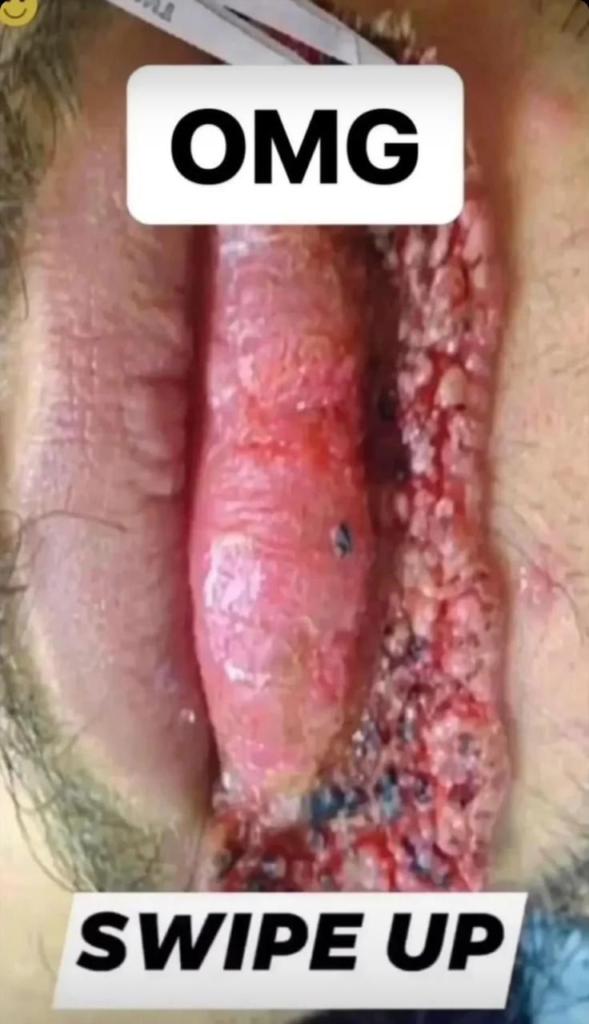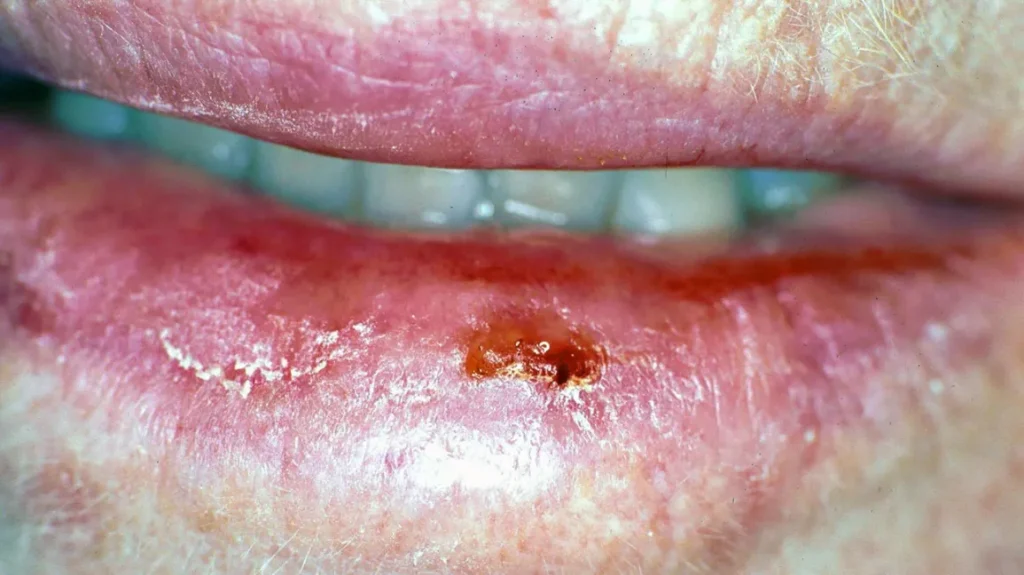😱 OMG! What Happened to These Lips? The Shocking Truth Behind This Horrifying Skin Condition

😱 OMG! What Happened to These Lips? The Shocking Truth Behind This Horrifying Skin Condition
What to know about lip cancer
Lip cancer is a form of cancer that starts in the lips and mouth. Early signs and symptoms can include sores or lumps on the lips or in the mouth. Treatment will depend on the size and location of the tumor.
Treatment options depend on the stage, size, and location of the tumor. However, lip cancer is often curable with early diagnosis and treatment.
Read on to learn about lip cancer, including symptoms, risk factors, diagnosis, and treatment of the condition. We will also discuss outlook or when to see a doctor.
A note about sex and gender
Sex and gender exist on spectrums. This article will use the terms “male,” “female,” or both to refer to sex assigned at birth. Learn more.
What is lip cancer?

Lip cancer is a type of oral cancer that begins in the mucosa of the mouth. This is the tissue that lines the mouth.
According to a 2022 study, more than 90% of oral mucosa cancers, including lip cancers, begin in the squamous cells of the epidermis. Squamous cells are thin, flat cells that lineTrusted Source the lips and other areas of the mouth. These cells grow out of control and form lesions or tumors on the lips.
Early diagnosis is key to treating the cancer and preventing it from spreading to other parts of the body.
Risk factors for developing lip cancer
Certain lifestyle and environmental factors can also increase a person’s risk of developing this disease. These factors include:
- heavy alcohol use
- smoking or using tobacco products
- contracting certain strains of the human papillomavirus (HPV), including strains 16 and 18
- prolonged exposure to natural or artificial sunlight, such as from tanning beds
- having undergone hemopoietic stem cell transplant
Signs and symptoms of lip cancer
The main symptomTrusted Source of lip cancer is a sore on the lips or inside the mouth that does not heal. According to the American Cancer Society (ACS), people who have mouth sores that do not heal within 2 weeksTrusted Source or that partially heal and then come back should see a doctor.
Other signs and symptoms of lip cancer may include:
- a lump on the lips or a noticeable thickening
- painful or numb lips
- bleeding from the lips
- a red or white patch on the lips
- tightness in the jaw that results from swelling
As with other types of cancer, lip cancer may not always have obvious symptoms in the early stages. People sometimes discover that they have lip cancer during a routine visitTrusted Source to their dentist, according to the ACS.
The symptoms of lip cancer can be similar to those of other conditions, so it is important to see a doctor or dentist about any unexplained lesions or bleeding from the lips. Even if the person does not have cancer, they may need treatment for an injury or infection.
What does lip cancer look like?
The early signs of lip cancer may be subtle. As the cancer grows and spreads, it may resemble a large wound or injury. Some things to look for includeTrusted Source:
- any growth on the lips, especially if it is discolored
- a wound on the lips, especially if it appears for no reason
- bleeding or crusty spots on the lips
- wounds that change the shape or size of the lips
- unexplained swelling on the lips, tongue, or mouth
A growth on the lips does not have to look like these pictures to be cancerous.

VIEW GALLERY6
How common is lip cancer?
Researchers estimated that, in 2020, there were 377,713 new casesTrusted Source of lip and oral cavity cancer globally.
According to the National Cancer Institute (NCI)Trusted Source, rates of lip cancer in the U.S. declined in the 30 years between 1992 and 2019 from 1.5 cases per 100,000 persons to 0.6 cases per 100,000 persons. The rate of decline slowed between 2008 and 2019, remaining roughly the same.
Based on data from 2017-2019, the NCI predicts that about 0.1% of men and women will receive a diagnosis of lip cancer at some point in their life.
When to see a doctor about lip cancer
A person should consult a doctor or dentist about any unusual changes to their lips or mouth, particularly lumps or other lesions that do not get better on their own.
Regular visits to the dentist increase the likelihood of detecting lip and other types of oral cancer early. It is especially important for people with a higher risk of developing lip cancer to have regular dental checkups.
If a dentist suspects or discovers lip cancer, the person needs to book an appointment with another healthcare professional. A doctor can help diagnose lip cancer and work with the person to develop an appropriate treatment plan.
Diagnosis of lip cancer
A doctor typically begins a diagnosis by reviewingTrusted Source a person’s symptoms, medical history, and risk factors. They may ask about:
- the family history of cancer and other diseases
- tobacco or alcohol consumption
- previous or current medical conditions
- history of dental procedures
The doctor will then carry out a physical examination of the person’s mouth. Typically, they will closely inspect the lips and the inside of the mouth for lumps and abnormalities. The doctor may also check the lymph nodes in the neck for swelling.
If the doctor suspects that a person has lip cancer, they will usually perform a biopsy. This test involves taking a small sample of skin from the affected area and examining it under a microscope for signs of cancer.
If the biopsy confirms a diagnosis of lip cancer, the doctor will order additional tests to help determine the stage of the cancer and if it has spread to other areas of the body. These tests may include imaging tests and an endoscopy, or the doctor may take more tissue samples.
Stages of lip cancer
Stages for lip cancer number from 1–4, with 1 being the earliest stage. Healthcare professionals use the following criteria to assign stages:
- Stage 1: The tumor is 2 centimeters (cm) or lessTrusted Source and the deepest point of tumor invasion is 5 millimeters (mm) or less.
- Stage 2: The tumor is larger than 2 cm but not more than 4 cm and the deepest point of tumor invasion is 10 mm or less. Alternatively, the tumor is 2 cm or less and the deepest point of tumor invasion is over 5 mm.
- Stage 3: The tumor:
- has spread to one lymph node that is 3 cm or less, on the same side of the neck as the primary tumor.
- is over 4 cm and the deepest point of tumor invasion is 10 mm or less.
- is over 2 cm but not more than 4 cm and the deepest point of tumor invasion is greater than 10 mm.
- Stage 4: The tumor has spread to other tissues, such as the skin of the face, lymph nodes, or bones. Healthcare professionals break this stage down further into stage 4A, 4B, and 4C, depending on where the tumor has spread and its size.
How quickly does lip cancer spread?
Overall, lip cancer survival rates are good — 91% at 5 yearsTrusted Source, according to the ACS. This means that lip cancer is not a particularly aggressive cancer. In other words, it does not typically spread quickly.
Because it is in a visible location on the body, a person might notice it earlier than some other cancers.
Treatment for lip cancer
The type of treatment for lip cancer typically depends onTrusted Source:
- the stage of the cancer
- the size and location of the tumor
- the person’s general health
A doctor will discuss the available treatment options with the person and work closely with them to develop a suitable treatment plan.
Standard therapy for lip cancer usually involvesTrusted Source a combination of surgery and radiation therapy. Surgeons aim to remove the tumor and restore the function and appearance of the lips. Radiation therapy involves the use of high-energy beams to kill tumor cells and prevent cancer from returning.
Removing the cancer increases the chances of fully curing it.
Clinical trials for other treatments are ongoing. Some of these treatments include:
- hyperfractionated radiation therapy
Preventing lip cancer
It is not always possible to prevent lip cancer. However, a person can reduce their risk of developing lip cancer by:
- using appropriate sun protection when outside, including sunscreen, lip balm with SPF protection, and a hat with a brim
- limiting or avoiding the use of tanning beds
- reducing alcohol intake
- quitting tobacco productsTrusted Source and avoiding tobacco smoke
- having regular dental checkups
Outlook for people with lip cancer
The outlook for people with lip cancer is generally good if a doctor detects and treats the disease early.
The ACSTrusted Source reports an overall 5-year survival rate of 91%. If the cancer spreads nearby, 5-year survival drops to 63%. If the cancer spreads even more and to distant areas of the body, survival rates at 5 years are 38%.
Lip cancer can recurTrusted Source even after a doctor removes it and the cancer is gone. If recurrence happens quickly, the outlook is often worse.
Summary
Early signs of lip cancer often include a lump or sore on the lips or inside the mouth that fails to heal. Lip cancer is most common in older males with light-colored skin, though it can happen to anyone. A person should not ignore any sore on the mouth.
The treatment options for people with lip cancer depend on the stage and size of the tumor. However, standard therapy usually involves a combination of surgery and radiation therapy. Early detection and treatment of lip cancer significantly improve a person’s outlook.
People can reduce their risk of lip cancer by using sun protection, limiting alcohol intake, and avoiding the use of tobacco products. Having regular dental checkups makes the early detection of lip cancer more likely.
